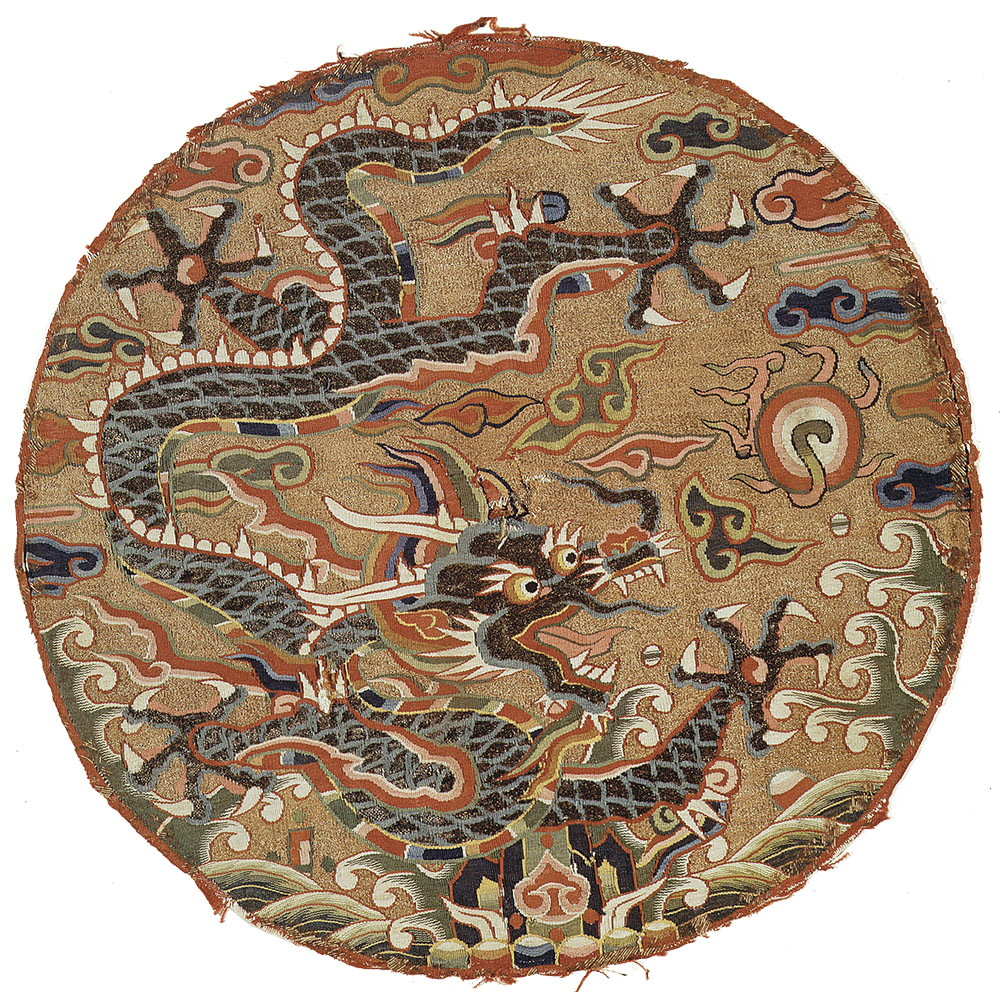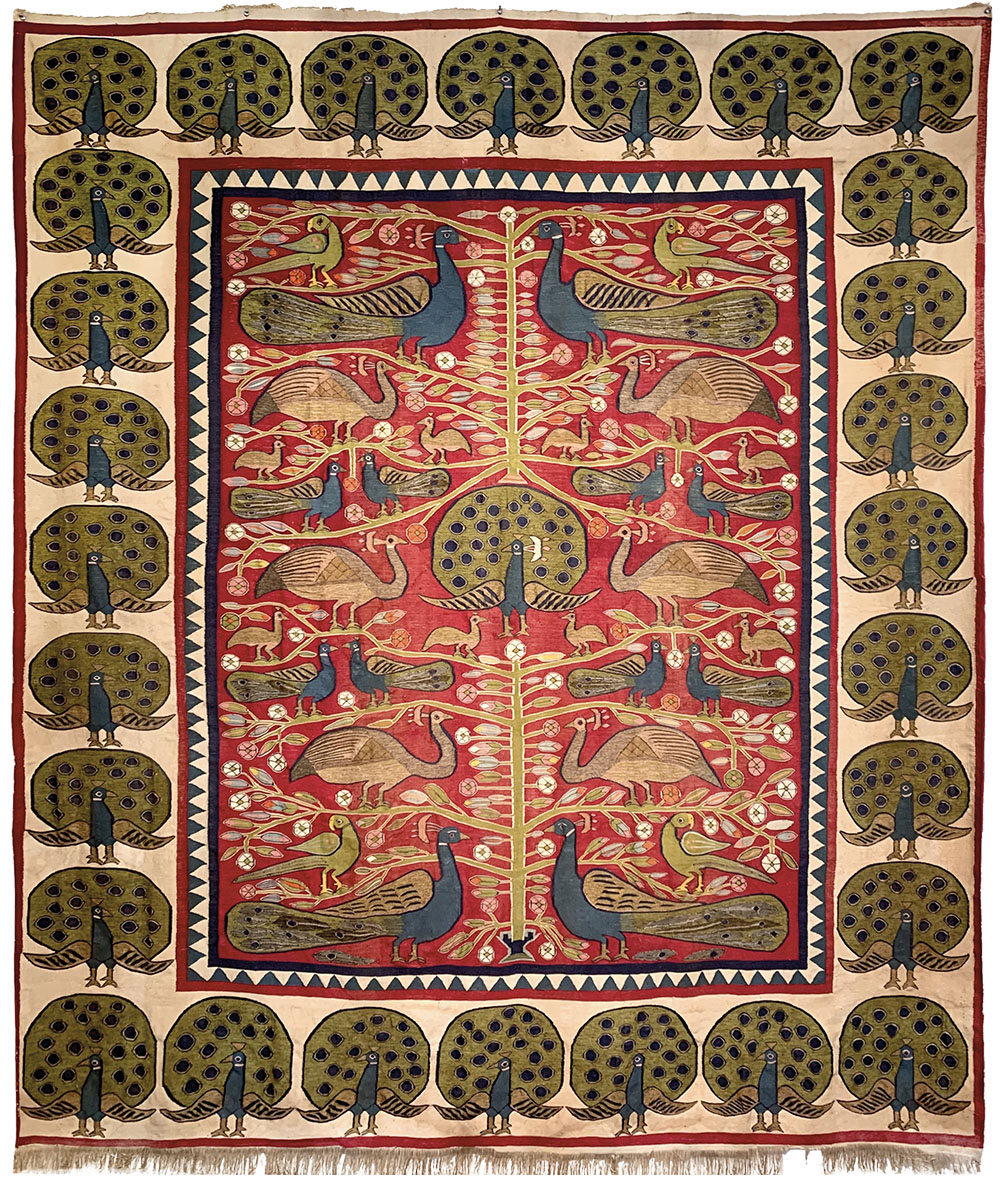Thread of Time: A Qing Kesi Roundel and an Indian Cotton Dhurrie
In the regular HALI feature Thread of time, we connect two seemingly very different textiles through material, technique, iconography or use. In these two tapestry-woven textiles, the link is the peacock. Rachel Meek notes that in one, peafowl and their chicks are accompanied by parrots, while in the other lustre is added to a lone dragon’s mythical scales using iridescent feather fibres from a real-life peacock.

Kesi roundel with five-clawed dragon design, China, late 17th century. Silk, metallic thread and peacock feather slit-tapestry weave, 0.30 x 0.31 m (11¾” x 12½”). Metropolitan Museum of Art, New York, Fletcher Fund, 36.65.32
Native to the Indian subcontinent, the peacock (Pavo cristatus) has long been prized in South Asia and further afield for its brilliant blue-green colouring and showy ocelli tail feathers—around 200 of which make up a mature bird’s train. These are moulted and regrown annually. Occasionally, individual peacock feather barbules were wrapped around thread and woven into 16th- and 17th-century Ottoman and Chinese textiles.
Such iridescent thread is used to great effect in this Qing-dynasty (164 4–1911) kesi slit-tapestry where it is perfectly placed, among silk and metal threads, to highlight the scales of a fiercely animated fiveclawed imperial dragon, claws flexed, eyes bulging, teeth bared.
Using the interlocking tapestry technique, in a different material and on a larger scale, is a late 19th-early 20th-century dhurrie from north India. Such utilitarian cotton flatweaves were traditionally used by all levels of Indian society as bed covers, prayer mats and floorcovers for rooms, festivals or palaces from at least the 17th century.
Two larger dhurries with similar designs and colour palettes, depicting various birds in a central tree on a red ground, are in the collection of the Varanasi royal family. Measuring 4.72 x 5.30 m and 4.20 x 4.50 m, these are housed at Varanasi’s Maharaja Banares Vidya Mandir Museum and appear in Dhurrie: Flatwoven rugs of India (1999) by Shyam Ahuja, who suggests that they mirror ‘one of the more famous 17th-century Mughal pile carpets, the “Peacock” rug, with an aviary of peacocks, cranes and other birds’, most likely citing a piece from Lahore, circa 1600, with a wonderful asymmetric design in the collection of the Museum für angewandte Kunst in Vienna (OR292), described by Erwin Gans-Ruedin in Indian Carpets as ‘brimming with life’ (1984, p.77).
The dhurrie shown here is closer in size to the MAK rug, its supposed source. Dhurrie designs are more symmetrical and less free than those of the pile rug—as one might expect from the technique—but no less lively. Whether by coincidence or design, the parade of peacocks with round fanned tails in the main border remotely echoes the border of the pile rug too, although its rows of roundels are formed by palmettes containing grotesque animal masks, a favoured Mughal (and Safavid) motif.

Dhurrie with a design of peacocks, peahens, peachicks and parrots perched in a tree, north India, late 19th-early 20th century. All cotton, interlocking tapestry weave, 2.03 x 2.34 m (6′ 8″ x 7′ 8″). Andy Lloyd, Bath
The peacock, India’s national bird, features in many Indian myths, and is also endemic to the country’s textiles, crossing borders between techniques and ages, as a symbol of grace, pride and beauty. Ahuja writes that in the north Indian states of Kutch and Rajasthan, it is considered bad luck to capture, or even to annoy, the alluring bird. Parrots meanwhile carry amorous connotations of courtship, being the mount of Kamadeva, the Hindu god of love and desire.
Although mythical, dragons are one of the three national animals of China, sharing the honour with the giant panda and red-crowned crane. They make regular appearances on Ming- and Qing-dynasty kesi robes and rank badges, standing as an auspicious sign of prosperity, power and luck. According to Chinese mythology, dragons can fly, despite their lack of wings. Contrary to popular belief, peacocks are capable of using their wings to achieve flight, in spite of their bountiful tails, but only for short distances; more often they strut.
This article appeared in HALI 203: The India Edition. Buy the issue here.
























Comments [0] Sign in to comment